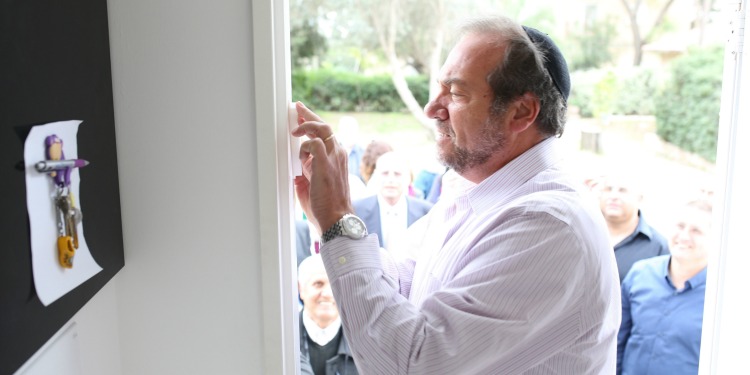16 Things to Know About the Mezuzah
The Fellowship | August 6, 2019

If you have ever entered a Jewish home, you probably noticed the object called a mezuzah hanging from the doorframe (Rabbi Eckstein can be seen above hanging one at the Fellowship House). You might not have known, however, that Bible commands this to be done: “These commandments that I give you today are to be on your hearts…Write them on the doorframes of your houses” (Deuteronomy 4:6-9). Now let’s learn a bit more about this biblical tradition, thanks to Chabad’s Yehuda Altein:
1. The Word Mezuzah Literally Means “Doorpost”
In Biblical Hebrew, the word mezuzah means doorpost. The verse instructing us to write a mezuzah reads, “You shall write [these words] upon the mezuzot—doorposts—of your house and upon your gates.” Talmudic literature applied the term to the scroll affixed to the doorpost, which is how we still refer to it.
2. It’s Handwritten on Parchment
A mezuzah must be written on the parchment of a kosher animal. The parchment must have been prepared explicitly for use as a sacred object. The words must be handwritten by an expert scribe well-versed in the intricacies of the script and its laws. Even the ink and quill are custom made to meet the necessary requirements.
3. It Contains the Shema
Each mezuzah scroll contains the first two portions of the Shema, beginning with the verse, “Hear o Israel, the L‑rd is our G‑d, the L‑rd is One.” Both of these selections contain G‑d’s instruction to affix the mezuzah: “You shall write [these words] upon the doorposts of your house and upon your gates.”
4. It Has Sha-dai Written on the Reverse
On the reverse side of the scroll, the scribe writes one of G‑d’s names: Sha-dai. The three letters of this name form an acronym for the Hebrew words Shomer daltot Yisrael, “Guardian of the doorways of Israel.” If you’ve noticed that mezuzah cases are often decorated with the letter shin, it’s because this name of G‑d begins with shin.
5. It Gave Us a Secret Code
Three additional words are written on the reverse side of the scroll: כוזו במוכסז כוזו. This seemingly incomprehensible sentence comprises the three names of G‑d that appear in the verse of Shema—Hashem Elokeinu Hashem—by replacing each letter with the following letter of the Hebrew alphabet (e.g., yud is replaced with chaf, hei is replaced with vav, and so on). These three words are written on the reverse side of the parchment, in the very same spot where the corresponding names of G‑d are written inside the scroll.
This type of spelling, nicknamed “mezuzah script,” was often used by Jews in Soviet Russia to write letters containing “incriminating” information…
